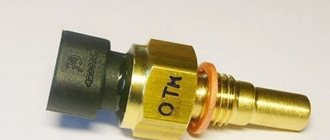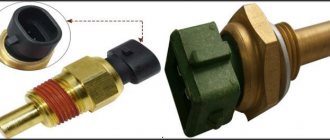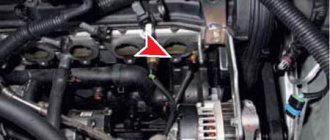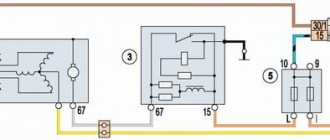The tenth family of the Tolyatti auto giant was equipped with injection engines. The first releases of cars were with 8-valve heads, and subsequent ones with 16-valve heads. Both engines were equipped with electronic control units (hereinafter referred to as ECU). The main controller collects readings from several sensors and adjusts the balanced operation of the engine (hereinafter referred to as the internal combustion engine). The temperature sensor on the VAZ 2110 is also responsible for interacting with the computer, and if it malfunctions, the “Check Engine” signal lights up, which in English means “Check the engine.” Next, we will tell you where the temperature sensor is located on the VAZ 2110, how to check and change it.
Attention! The injection "tens" have 2 coolant sensors. One for the arrow on the dashboard, and the second for exchanging data with the ECU and turning on the radiator fan. It's called DTOZH. The article is dedicated to him.
Principle of operation
The mechanism of action of the temperature sensor on the VAZ 2110–2112 family is based on changing resistance parameters depending on the ambient temperature t°C. In essence, we have before us an electronic resistor with a negative temperature coefficient. That is, the lower the t°C, the higher the resistance of the device, and vice versa.
Table 1. Operating temperatures and parameters of DTOZH
| Temperature, t°C | Resistance, Ohm |
| 100 | 177 |
| 40 | 1459 |
| 25 | 2796 |
| 0 | 9420 |
| −20 | 28680 |
| −40 | 100700 |
The presented values can be used to check the sensor with a tester. More on this below.
What function does DTOZH perform in the ECU system?
There is no damper (choke) on injection machines. Now the fuel is enriched or leaned by the control unit using the t°C values coming from the DTOZH. In addition, the main controller monitors the operating temperature of the engine and gives a command to turn on the fan if it overheats.
CO functions
The cooling system is responsible for removing excess heat that is generated during operation of the power unit. If the engine overheats, the consequences can be catastrophic.
Cooling system diagram
In addition to heat removal, CO additionally performs several other functions:
- Helps accelerate engine warming up to optimal operating temperature;
- Warms the air inside the cabin;
- Cools the lubrication system;
- Cools exhaust gases.
In total, three types of cooling systems can be used on cars:
- Air. The cooling process is carried out by blowing air over the units;
- Liquid. The coolant is a special liquid - water, antifreeze or antifreeze;
- Combined. Both types of cooling are mixed in one system.
antifreeze or antifreeze acts as a cooler .
Causes and symptoms of malfunction
Service workshop technicians say that in 90% of cases, the breakdown of the temperature sensor on a VAZ and other brands of cars occurs due to natural causes. Most often, a break in the internal contacts of the resistor occurs. As a result, the DTOZh sends incorrect parameters to the ECU, for example, engine starting t° within 0 °C. The control unit considers the engine cold and gives a command to another sensor - the mass air flow sensor - to reduce the air supply, that is, to enrich the mixture. Therefore, a warmed-up engine begins to work strangely, “excitedly” with failures. Here are 3 more most common reasons for the incorrect operation of the DTOZH:
- The seal of the sensor housing is broken.
- There was a break in the electrical wires.
- The power supply has fallen off.
In the above cases, the ECU does not see the DTS system, so it attracts the driver’s attention with a “Check Engine” signal on the dashboard. In this case, the operation of the car becomes unusual:
- the engine starts with difficulty and tends to stall;
- the speed fluctuates even on a warm engine;
- strong detonation is felt;
- the former power is lost.
In addition, fuel consumption increases, and dark smoke comes out of the exhaust pipe. It is necessary to make a diagnosis. To do this, you can go to a car service center, or install a special application on your smartphone and buy a Bluetooth adapter.
Possible problems of the TOZh and MVR sensor on the VAZ 2110-2112
The meter, which determines the degree of heating of the coolant, is an extremely reliable element. However, it has very characteristic malfunctions:
- loss of contacts in the electrical connector, inside the sensor or in the connection diagram;
- problems with the insulation of the device, defects in the insulation of the plug connector, short circuit.
It is quite simple to understand that the temperature sensor of the VAZ 2110 is faulty, because through a logical controller it controls the operation of the fan, which turns on when the internal combustion engine is sufficiently warmed up. Accordingly, based on erroneous or missing information received from the regulator, the controller may make incorrect decisions, causing engine overheating or excessive fuel consumption due to difficulties in reaching normal temperature conditions.
Engine overheating
Problems with the mass air flow meter can be determined by the corresponding “Check Engine” indication on the dashboard of the VAZ 2110 and characteristic symptoms of a malfunction:
- the car noticeably loses power and at the same time consumes much more fuel;
- your car now accelerates and starts poorly when the engine is warm.
Diagnostics of the mass air flow sensor VAZ 2110
If you have doubts about the operation of the MRI sensor, simply disable it. If after this the car’s performance has stabilized somewhat, the problem is definitely in the incorrect fuel consumption parameters set by the regulator. This does not mean that you can drive without it at all, since gasoline consumption in this mode, which is an emergency mode, is also not optimal.
We start the self-diagnosis mode, read the error codes of the temperature sensor
Being extremely simple, the operation will help you correctly identify possible problems with the car based on the information that the electronic microprocessor controller receives from the sensors.
- While holding down the daily mileage reset button, turn the ignition key. You can check the functionality of all elements of the dashboard.
- Press the reset button again twice, thereby skipping the information about the firmware version, we can observe error codes. By holding down the reset button, you reset the error values for re-diagnosis and verification of troubleshooting.
Where is DTOZH located?
All front-wheel drive VAZ cars received a transverse internal combustion engine. If you look down, between the cylinder head and the air filter housing, you can see the location of the DTOZH. It is built into the coolant flange pipe and looks in the direction of travel, that is, towards the radiator. A block with two wires fits into it. (A little lower, directly in the block, there is another coolant temperature sensor. Thanks to it, we can see the t°C level on the dashboard. 1 white-green wire goes to the device).
How to replace the coolant temperature sensor on a VAZ 2110-VAZ 2112?
Attention! Before you buy a new sensor, look at the markings on the old one and exactly the same markings on the new one, buy, if you buy any other sensor, it may simply not give you readings or simply show them to be incorrect, besides, it comes with with a new sensor, check if necessary, a new copper washer is included, if it is not there, buy it separately, for clarity, in the picture below this washer is marked with a red arrow, but there is only one but! This sensor, shown in the photo below, does not at all relate to these sensors, which we will break down with you today, as follows from the photo below, which is taken for illustration only, so that you understand that it is intended for a copper block and where it can be on the counter!
Dismantling: 1) First, check which elements prevent access to this sensor, here is an example of an interfering air filter housing, think about how to remove it or not, read about how to remove it in the article: “replacing the air filter housing in a VAZ.”
2) Moving on, remember that we told you that the coolant system needs to be drained, so use the article called "Changing the Coolant in Your Car" which explains how to drain the coolant, but you may not need to drain the sensor for replacement, just a little dirt in the engine as a whole, do whatever you see fit, both ways will help you replace either of the two sensors on your car as normal.
3) So, after draining the liquid, select the sensor to be replaced and do not forget to remove the negative clamp from the battery (read about how to remove the clamp “here in this article”), after selecting, disconnect everything that is connected to the sensor that you are going to change (see . photo below)
After disconnecting the sensor (also look at the photo below, they are clearly visible), unscrew the sensor and remove it from the car, replace it with a new sensor, if the coolant is not drained from the system, the note below says carefully
Attention! If you decide not to remove the coolant, but simply replace the sensor, the first thing to do is take the second sensor in your hands and twist the old sensor a little, when you can turn it by hand, move the key to the side and manually the sensor begins to turn, do it slowly and hold the sensor by the hole because you won't be sure when you unscrew it and the fluid will start to flow out around the edges of the sensor, after unscrewing the sensor take it out and put a new one in its place, the fluid will flow out a little if you do it right, finally, Screw the new sensor all the way in and check if it works by cranking the engine and seeing if all the symptoms go away or not!
Once the sensor is installed, everything is done in the reverse order of disassembly, but be sure to apply sealant (this is up to you) to the edges of the sensor as shown in the photo below (the bottom photo shows a different sensor, just for clarification), but if you have already finished the sensor and you don't have anything to leak, don't forget to lubricate the edges.
Checking the coolant temperature sensor:
We check the sensors, as we said, are identical, they just have slightly different readings, check the container or lift it (a glass is convenient or just a kettle can be used) and heat it to a certain temperature (the temperature to which the container can be heated. shown in the pictures below, for example, warm it up up to 100 degrees and check with a thermometer, lower the sensor into heated water (but only the part that was wrapped in the holes in the engine, the sensor contacts do not need to be lowered into the water), then connect the wires to the sensor and check its resistance with an ohmmeter.
Which sensor to choose
Independent automotive industry experts and service workshop specialists are of the opinion that it is better to buy original spare parts or branded analogues. The latter are selected according to codes in special combination programs. The coolant temperature sensor, VAZ 2110–2112 family, has serial number 21120–3851010–00. Sometimes at the end, instead of 00, you can see: 01, 02, 03. This indicates that the device was made at one of the related AvtoVAZ enterprises.
Table 2. Price of the original DTOZH and its foreign analogues
| Manufacturer | Number | Amount, rub. |
| GM AvtoVAZ | 21120–3851010–00 | 250 |
| AvtoVAZ | 21120–3851010–82 | 165 |
| Magneti marelli | 1719 16011 150 | 355 |
| Hella | 6PT 009 107–271 | 735 |
| Eps | 1.830.098 | 1080 |
Sources: autopiter.ru, exist.ru.
Interesting fact. Some owners buy exclusively foreign spare parts for their “tens”. The same shock absorbers, struts, springs, timing belts, electrical equipment and other parts “from there” last much longer.
Articles
For oxygen sensors, the designation 21120-3850010 was first used. Then an article appeared with the numbers 1118 (see photo). It appears to be a new type of sensor. It will be easier to use BOSCH articles.
Exhaust system of VAZ-21120 engine
We list the article numbers of the remaining sensors:
- Mass air flow sensor (21124 or 21120): 21083-1130010-01, -10, -20;
- Mass air flow sensor (motor 21120 with ECU January 4.1): 2112-1130010, -01;
- DPDZ: 2112-1148200;
- РХХ: 2112-1148300-02;
- DPKV: 2112-3847010, -01, -03, -04;
- DTOZH: 2112-3851010, -01, -02, -05;
- Speed sensor: 2110-3843010-13, -18;
- DPRV: 2112-3706040, -02, -03;
- DD: 2112-3855020, -01, -02, -03;
- Oil pressure sensor: 2106-3829010, -01, -02;
- Antifreeze level sensor: 2110-3839310-10, -11, -12, -13, -14;
- Coolant temperature indicator sensor: 2101-3808600, -02, 2106-3828010.
The last three sensors are not connected to the ECU. However, a rough road sensor (2123-1413130) can be connected. It affects the operation of the engine, although it is attached to the body.
In general, on VAZ-2112 hatchbacks, sensors may be different from those indicated in the list. But then we are talking about an 8-valve engine. And everything that we indicated applies to 16 valves, here is a diagram of this engine.
How to check
There are many cases in history when the owner installs a new spare part, but it does not work. Therefore, after purchasing a temperature sensor, it is recommended to measure the resistance before installing it on the same VAZ or another car. To do this you will need a multimeter (tester). We convert it to an ohmmeter. At room temperature (+23 °C, +25 °C), the readings should be around 2780 Ohms (as in table No. 1). If you lower the DTOZH into a glass of boiling water (+100 °C), hold it for a while and take readings, a result in the range of 175–180 Ohms should appear on the tester screen. This means the purchase is in good condition. Can be installed on a car.
List of error codes issued that indicate a malfunction of the temperature sensor:
Codes 0112 and 0113 identify problems with the MVR associated with low and high temperatures, respectively. Don't rush to buy a new sensor. Since the element is an ordinary thermistor that changes resistance values depending on temperature.
Error codes for mass air flow sensor on VAZ 2110
It is very easy to check it with a multimeter by removing it from the VAZ and immersing it in water brought to the boiling point, measure the resistance as the liquid cools and compare it with the table values. If everything is normal, the problem may be caused by a clogged sensor or contacts.
Codes 0115 and 0116 indicate that the coolant regulator readings are incorrect. This may also be due to sensor failure, short circuit, or other problems discussed earlier in the article.
Codes 0117 and 0118, finally, indicate that the temperature recorded by the VAZ 2110 TOZH meter is outside the normal range. A seven on the end means the values are too low, and an eight on the end means they are too high. In this case, it is worth checking the entire cooling system, including the regulator itself.
Replacement
Before repairs, it is necessary to carry out a number of preparatory measures. First, you should choose a level area for the machine. It can be in the garage, it can be outdoors. Secondly, prepare the tool: open-end and ring wrenches (19 mm, 13 mm, 10 mm, 8 mm). You will also need a capacious medical syringe of 100–250 ml, a 15–20 cm dropper tube and a 0.5–1 liter jar (so as not to drain the antifreeze/antifreeze). The sequence of actions is as follows:
- We wait until the engine cools down completely.
- Use a syringe to pump out the coolant from the expansion tank (100–200 ml).
- Unscrew the negative terminal of the battery (10–13 mm wrench).
- Unscrew the air filter housing fasteners (8 mm wrench).
- Carefully tilt the “pan” to the right.
- Disconnect the power supply from the DTOZH.
- We unscrew the sensor (19 mm wrench).
- We clean the landing area from dirt.
- We screw in the new DTOZH.
The assembly must be done in reverse chronology. There is no need to use sealant, since the copper O-ring fits perfectly and seals the connection. Let's start the engine. We check its operation and inspect the repair area for antifreeze leaks. The entire event takes 15–20 minutes.
Why does the engine temperature sensor break?
In fact, there are not many of them. On VAZ 2114, 2110 or 2107 cars, the causes of breakdown are not much different.
First of all, you should pay attention to the entire cooling system - evaluate the integrity of the wiring, the quality of contacts and terminals, the serviceability of fans, as well as the level and quality of antifreeze.
All these factors can lead to the fact that the sensor fails earlier than the car owner expects (not “if”, but “when”, because any part fails sooner or later, and something as small and actively used is even more so)
Thus, before installing a new analyzer in place of the faulty one, it is worth making sure that the entire system is working normally, so that the installed part does not burn out prematurely because the car owner was too lazy to look for breaks in the wiring.
Where to buy car accessories
Spare parts and other products for the car are easily available for purchase at auto stores in your city. But there is another option that has recently received significant improvements. You no longer need to wait a long time for a parcel from China: the AliExpress online store now offers the opportunity to ship from transshipment warehouses located in various countries. For example, when ordering, you can specify the “Delivery from the Russian Federation” option.
Follow the links and choose:
| 12V car alarm, engine start/stop button, anti-theft system | Universal 10mm Oil Temperature Gauge for Cars | Automotive Electric Throttle Actuator Controller |
| Backlit Tire Pressure Gauge, High Precision Digital Meter | Set of screwdrivers for removing seals | 20 pcs crimp clamps with pliers |
A little history
The VAZ 2110 was produced from the end of the 20th century until the middle of the first decade of the 21st century. During its existence, the top ten managed to gain a huge number of fans and underwent a large number of changes.
The tenth VAZ family was initially equipped with 8-valve carburetor engines that had common roots from the G8 engines. Time moved forward and AvtoVAZ needed to develop further, and at the end of the 90s, an injection engine was installed on the top ten for the first time, which was distinguished not only by a new injection system, but also by the number of valves; some new engines received a doubled number of valves from 8- mi to 16.
To operate an engine with an injection system, you need a huge number of different sensors responsible for the operation of the internal combustion engine, and the VAZ 2110 is no exception; the dozens of injection engines have many different sensors installed that ensure correct and smooth operation of the engine.
In this article we will talk about VAZ 2110-12 sensors, their symptoms of malfunction and installation locations.











